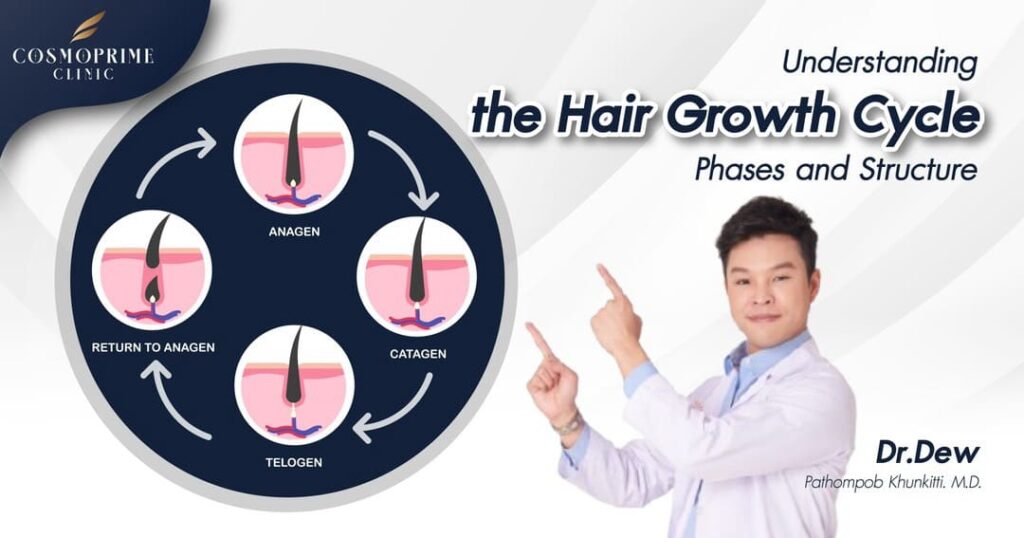The Hair Growth Cycle Explained
Did you know that the average human head has around 100,000 hair follicles, with each hair growing approximately 0.5 to 1 cm per month? As we age, hair growth slows, and hair loss becomes more common. Understanding the hair growth cycle can help you maintain healthier, stronger hair.
In this article, we’ll break down the structure of hair and the three key phases of the hair growth cycle.

Hair Structure: What Is Hair Made Of?
Hair is composed of two main parts:
- Hair Shaft – The visible part of the hair that grows above the scalp.
- Hair Root – The portion embedded beneath the scalp, housed in the hair follicle.
✅ Hair Shaft:
- This part determines your hair’s appearance—whether it’s straight, wavy, or curly.
- Hair color depends on melanin pigments:
- Eumelanin – Responsible for black and brown hair.
- Pheomelanin – Responsible for blonde and red hair.
✅ Hair Root:
- The root lies inside the hair follicle, which anchors the hair in place.
- At the base of the follicle is the hair bulb, where blood vessels nourish the hair and stimulate growth.
- Hair loss occurs when these cells become inactive or damaged, preventing new hair growth.

The 3 Phases of the Hair Growth Cycle
Hair growth is a continuous process, but it occurs in three distinct phases:
1. Anagen Phase – The Growth Stage
- Duration: Approximately 3 years (can last up to 7 years in some individuals).
- Activity: Hair actively grows at a rate of 1 cm per month.
- Percentage of Hair: 80-90% of your hair is in this phase.
💡 Fun Fact: The longer your hair remains in the anagen phase, the longer it can grow. A shorter anagen phase can lead to thinning hair or baldness.
2. Catagen Phase – The Transition Stage
- Duration: 2-3 weeks.
- Activity: Hair growth slows and detaches from the blood supply.
- Percentage of Hair: Around 1% of your hair is in this phase.
This brief regression period allows the follicle to prepare for a new cycle of hair growth.
[/col_inner_3] [/row_inner_3] [row_inner_3] [col_inner_3 span__sm=”12″]3. Telogen Phase – The Resting Stage
- Duration: 3 months.
- Activity: Hair stops growing and eventually sheds.
- Percentage of Hair: Approximately 10% of your hair is in this phase.
Why Does Hair Fall Out?
Human hair follows a mosaic pattern—shedding occurs randomly across the scalp. This is different from animals, where shedding happens in waves or specific areas.
Common causes of hair loss include:
- Genetics – Hereditary hair thinning or baldness.
- Hormonal Changes – Pregnancy, menopause, and thyroid issues.
- Stress – Can trigger sudden hair shedding (telogen effluvium).
- Nutrient Deficiency – Lack of iron, protein, or vitamins can weaken hair.
How to Support Healthy Hair Growth
To maintain a healthy hair cycle, follow these tips:
✅ Balanced Diet – Eat protein-rich foods (eggs, fish, nuts) for hair strength.
✅ Scalp Care – Keep your scalp clean and hydrated.
✅ Avoid Harsh Treatments – Minimize heat styling and chemical processing.
✅ Consult a Specialist – If experiencing excessive hair loss, seek professional advice.
Concerned About Hair Loss? We Can Help!
Understanding your hair’s life cycle is the first step toward maintaining and improving hair health.
[row_inner_4] [col_inner_4 span__sm=”12″]references:
- Olsen EA. Hair. In: Freedberg IM, Eisen AZ, Wolff K, et al. editors. Fitzpatrick’s dermatology in general medicine. 5th ed. New York: McGraw-Hill; 1999; 729-51.
-
Shapiro J, Lui H. Common hair loss disorders. In: Hordinsky MK, Sawaya ME, Scher RK, editors. Atlas of hair and nails. Philadelphia: Churchill Livingstone; 2000;91-103.



